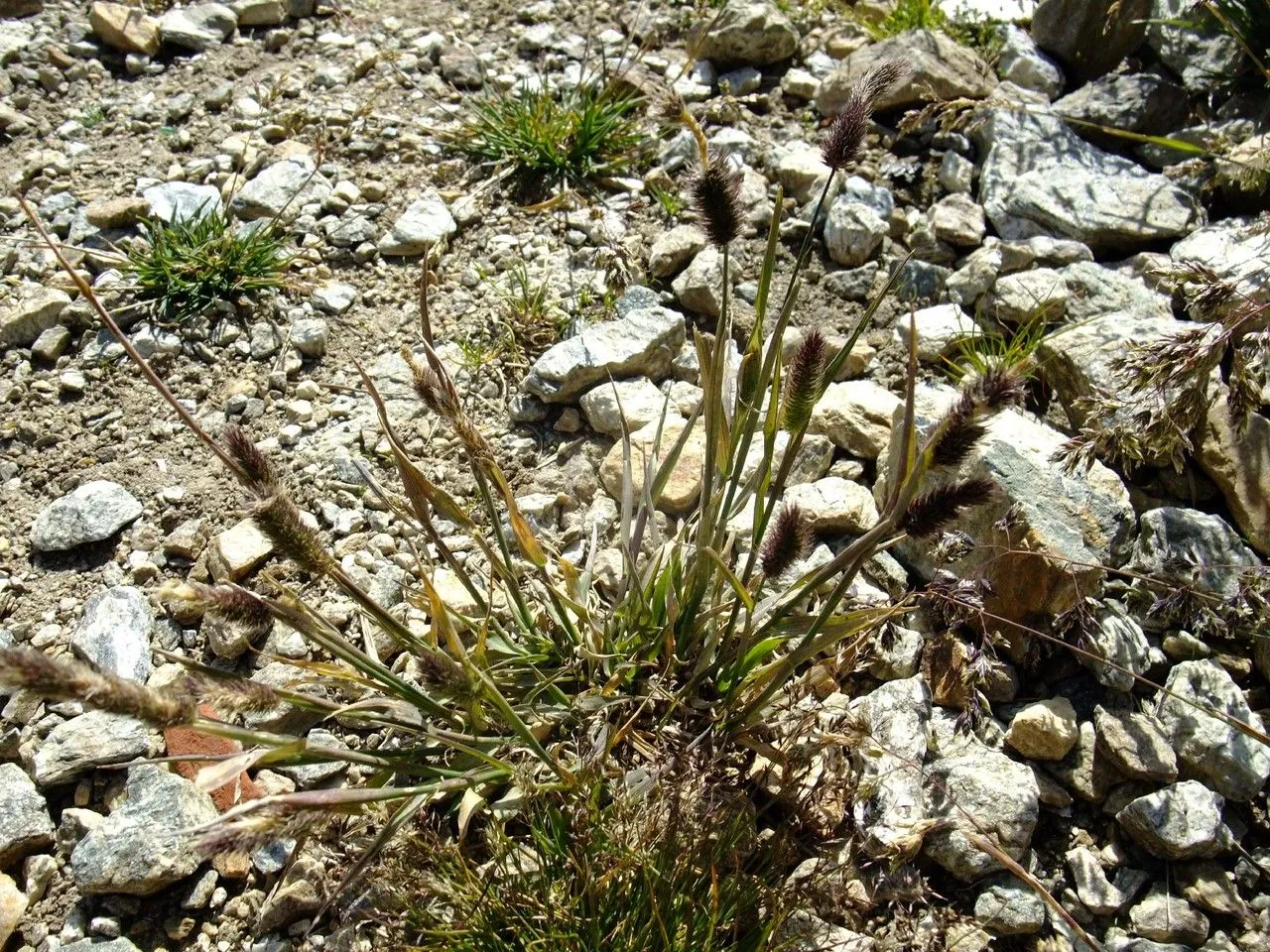
Author: L.
Bibliography: Sp. Pl.: 59 (1753)
Year: 1753
Status: accepted
Rank: species
Genus: Phleum
Vegetable: False
Observations: Subarctic & Temp. Northern Hemisphere to Guatemala, S. South America, South Georgia
Alpine timothy, scientifically recognized as Phleum alpinum, is an intriguing and resilient species belonging to the Poaceae family. Originally described by the renowned botanist Carl Linnaeus in his seminal work “Species Plantarum” in 1753, this grass species has established itself across a wide geographical range, from the subarctic and temperate regions of the Northern Hemisphere down to as far south as Guatemala, and extending into South America including the remote South Georgia island.
Known for its adaptability to harsh climates, Alpine timothy thrives in alpine and subalpine zones, where it often finds its habitat in moist meadows, along streams, and in other damp environments. Notably, this plant exhibits significant ecological versatility, contributing to the biodiversity of grassland communities in varied geographical landscapes.
Characterized by its tufted growth form, Alpine timothy has narrow, linear leaves and distinctive cylindrical flower spikes. These floral structures, composed of numerous tiny florets, are not only crucial for the plant’s reproduction but also serve as a valuable food source for grazing animals. Its robust nature makes it an important component in pastures and wilderness areas, where it can be found alongside other hardy native species.
Alpine timothy owes much of its ecological success to its impressive adaptability. It can endure cold temperatures and recover effectively after disturbances, making it a vital species for maintaining soil stability and preventing erosion in fragile alpine ecosystems. This grass can also be a significant contributor to vegetation cover in disturbed areas, aiding in the regeneration of natural habitats.
In conclusion, Phleum alpinum stands out for its ecological importance and widespread distribution. It epitomizes the resilience of alpine flora, showcasing how plants can thrive in some of the world’s most challenging environments.
Deu: alpen-lieschgras
Eng: alpine cat’s-tail, alpine timothy, mountain timothy
Nor: fjeld-kjempe
Nno: fjelltimotei
Nob: fjelltimotei
Swe: fjälltimotej, pohjantähkiö, fjällkampe
Fin: pohjantähkiö
Fra: fléole alpine, fléole des alpes, phléole alpine
Sme: luohtutimoteija
Cym: rhonwellt alpaidd, rhonwellt y mynydd
En: Alpine timothy, Mountain timothy, Alpine cat’s-tail, Alpine Cat’s tail, Cat Tail Grass
Bg: Алпийска тимотейка
Ca: Flèum alpí
Zh: 高山梯牧草
Da: Fjeld-Rottehale
Nl: Alpendoddegras
Fi: Pohjantähkiö
Fr: Fléole alpine, Fléole des Alpes, Phléole alpine, Phléole des Alpes
De: Alpen-Lieschgras, Alpen Lieschgras
He: איטן האלפים
Is: Fjallafoxgras
It: Codolina alpina
Se: Luohtutimoteija
No: Fjeld-kjempe
Nb: Fjelltimotei
Nn: Fjelltimotei
Fa: دمگربهای کوهسری
Pl: Tymotka alpejska
Sv: Fjälltimotej, Pohjantähkiö, Fjällkampe
Zh-tw: 高山梯牧草
Uk: Тимофіївка альпійська
Cy: Rhonwellt y mynydd, Rhonwellt Alpaidd
Taken Jul 7, 2016 by Tela Botanica − Genevieve BOTTI (cc-by-sa)
Taken Aug 1, 2020 by Petra Peet (cc-by-sa)
Taken Jul 26, 2020 by Patrick Jansen (cc-by-sa)
Taken Aug 25, 2021 by Manuëlle (cc-by-sa)
Taken Jul 26, 2020 by Patrick Jansen (cc-by-sa)
Taken Jun 20, 2021 by Franco Colnago (cc-by-sa)
Taken Aug 8, 2021 by Pietro Brignoli (cc-by-sa)
Taken Aug 23, 2022 by Joseph Littlehorn (cc-by-sa)
Taken Oct 12, 2021 by Tiberius Kirke (cc-by-sa)
Taken Aug 25, 2021 by Manuëlle (cc-by-sa)
Taken Jul 13, 2013 by Tela Botanica − Yoan MARTIN (cc-by-sa)
Taken Aug 9, 2022 by Tristan Jaton-Maria (cc-by-sa)
Taken Feb 17, 2022 by Beytullah AYDIN (cc-by-sa)
Taken Jul 27, 2012 by Tela Botanica − Yoan MARTIN (cc-by-sa)
Taken Jul 13, 2013 by Tela Botanica − Yoan MARTIN (cc-by-sa)
Taken Aug 9, 2022 by Tristan Jaton-Maria (cc-by-sa)
Taken Jul 27, 2012 by Tela Botanica − Yoan MARTIN (cc-by-sa)
Taken Jul 27, 2012 by Tela Botanica − Yoan MARTIN (cc-by-sa)
Taken Jul 13, 2013 by Tela Botanica − Yoan MARTIN (cc-by-sa)
Taken Jul 27, 2012 by Tela Botanica − Yoan MARTIN (cc-by-sa)
Taken Jul 18, 2012 by Tela Botanica − Yoan MARTIN (cc-by-sa)
Taken Aug 20, 2015 by Tela Botanica − Liliane ROUBAUDI (cc-by-sa)
Taken Aug 29, 2021 by Yvan Bultel (cc-by-sa)
Taken Jul 13, 2013 by Tela Botanica − Yoan MARTIN (cc-by-sa)
Taken Jul 18, 2012 by Tela Botanica − Yoan MARTIN (cc-by-sa)
Taken Jul 7, 2020 by Martin Allan (cc-by-sa)
Taken Jun 13, 2020 by Renaud Brochiero (cc-by-sa)
Taken Jan 1, 1970 by Photoflora – L’Abbé COSTE (©)
Taken Aug 25, 2019 by Jot Ess (cc-by-sa)
Taken Aug 8, 2021 by Pietro Brignoli (cc-by-sa)
© copyright of the Board of Trustees of the Royal Botanic Gardens, Kew.
© copyright of the Board of Trustees of the Royal Botanic Gardens, Kew.
© copyright of the Board of Trustees of the Royal Botanic Gardens, Kew.
Growth form: Bunch
Growth habit: Graminoid
Growth rate: Slow
Ph maximum: 7.5
Ph minimum: 5.0
Light: 8
Atmospheric humidity: 6
Soil nutriments: 6
Family: Myrtaceae Author: (F.Muell.) K.D.Hill & L.A.S.Johnson Bibliography: Telopea 6: 402 (1995) Year: 1995 Status:…
Family: Rubiaceae Author: Pierre ex A.Froehner Bibliography: Notizbl. Bot. Gart. Berlin-Dahlem 1: 237 (1897) Year:…
Family: Sapindaceae Author: Koidz. Bibliography: J. Coll. Sci. Imp. Univ. Tokyo 32(1): 38 (1911) Year:…
Family: Asteraceae Author: A.Gray Bibliography: Pacif. Railr. Rep.: 107 (1857) Year: 1857 Status: accepted Rank:…
Family: Fabaceae Author: Medik. Bibliography: Vorles. Churpfälz. Phys.-Ökon. Ges. 2: 398 (1787) Year: 1787 Status:…
Family: Aspleniaceae Author: (Cav.) Alston Bibliography: Bull. Misc. Inform. Kew 1932: 309 (1932) Year: 1932…